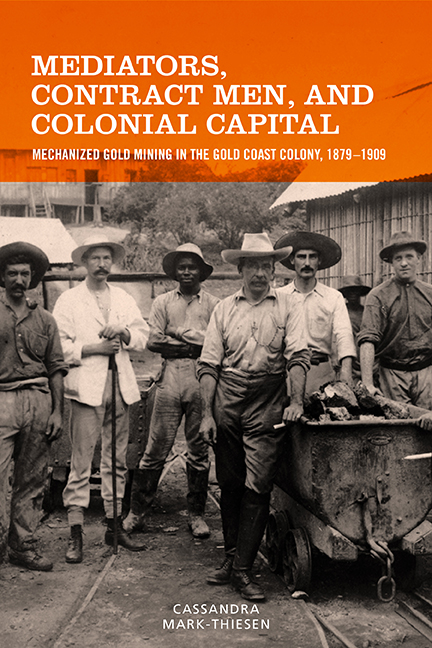 Mediators, Contract Men, and Colonial Capital
Mediators, Contract Men, and Colonial Capital Book contents
- Frontmatter
- Dedication
- Contents
- List of Illustrations
- Acknowledgments
- Introduction
- 1 Prospectors, Politicians, and the Question of “Progress”: The First and Second Gold Booms in Wassa
- 2 Labor Recruitment in the Nineteenth Century: The Place of Practicality
- 3 Disrupted Recruitment at the Turn of the Twentieth Century: Women, Whites, and Other Labor Agents
- 4 Government Strategies for Assisting the Mines
- 5 Labor Agents, Chiefs and Officials, 1905–1909: The Incorporation of the Northern Territories’ Labor Reserve
- Conclusion
- Notes
- Bibliography
- Index
5 - Labor Agents, Chiefs and Officials, 1905–1909: The Incorporation of the Northern Territories’ Labor Reserve
Published online by Cambridge University Press: 29 May 2021
- Frontmatter
- Dedication
- Contents
- List of Illustrations
- Acknowledgments
- Introduction
- 1 Prospectors, Politicians, and the Question of “Progress”: The First and Second Gold Booms in Wassa
- 2 Labor Recruitment in the Nineteenth Century: The Place of Practicality
- 3 Disrupted Recruitment at the Turn of the Twentieth Century: Women, Whites, and Other Labor Agents
- 4 Government Strategies for Assisting the Mines
- 5 Labor Agents, Chiefs and Officials, 1905–1909: The Incorporation of the Northern Territories’ Labor Reserve
- Conclusion
- Notes
- Bibliography
- Index
Summary
The influx of capital into the Wassa mines reached a new low in 1905, leading many mining companies to cease production, and leaving just a few more-established and technically better-equipped ventures to prove that the industry could indeed pay its way. This period marked the end of the second gold boom in Wassa. The reduction in the number of competing mines did not, however, improve recruitment in the long term. The surplus of labor that had resulted from the closing of the smaller companies was quickly neutralized, because laborers continued to opt for work in the agricultural sector, especially cocoa farming. Therefore, within just a few months’ time, the gold mines found themselves on the verge of another severe labor shortage. For 1906, Frank Cogill, the secretary for mines, reported that as anticipated, “there has been a shortage of labour, which, although not sufficient to stop the mines from working, had the effect of forcing some companies to pay higher wages than those adopted by the Mine Managers’ Association.” This was the moment when the mines and the administration came together to collaborate on a new labor experiment, one made possible by colonial territorial expansion into the north as well as the expansion of the government railway. The discovery of labor-dense pockets in the savanna region of the north brought employers in the gold mines significant relief. Recruiting from these areas, generally directly through chiefs and colonial officials, forcibly detached wages from the demands of the market. As political promises infiltrated the recruitment machinery from the Northern Territories and became a huge motivating factor for local authorities, wage rates no longer had to adhere to the laws of supply and demand. However, in spite of all the cost-cutting measures and deception involved, this pattern of recruitment became the source of sharp political and social conflict.
This study has thus far aimed to show indirect recruitment through African labor agents as a system of voluntary bondage that could be precarious for both recruits, as well as recruiters, albeit in different measure and with different implications. It has done so in order to expand the discussion of the mobilization of African workers after the legal end of slavery, which has been dominated by the theme of colonial forced labor and other forms of mobilization similar to slavery.
- Type
- Chapter
- Information
- Mediators, Contract Men, and Colonial CapitalMechanized Gold Mining in the Gold Coast Colony, 1879–1909, pp. 145 - 157Publisher: Boydell & BrewerPrint publication year: 2018


